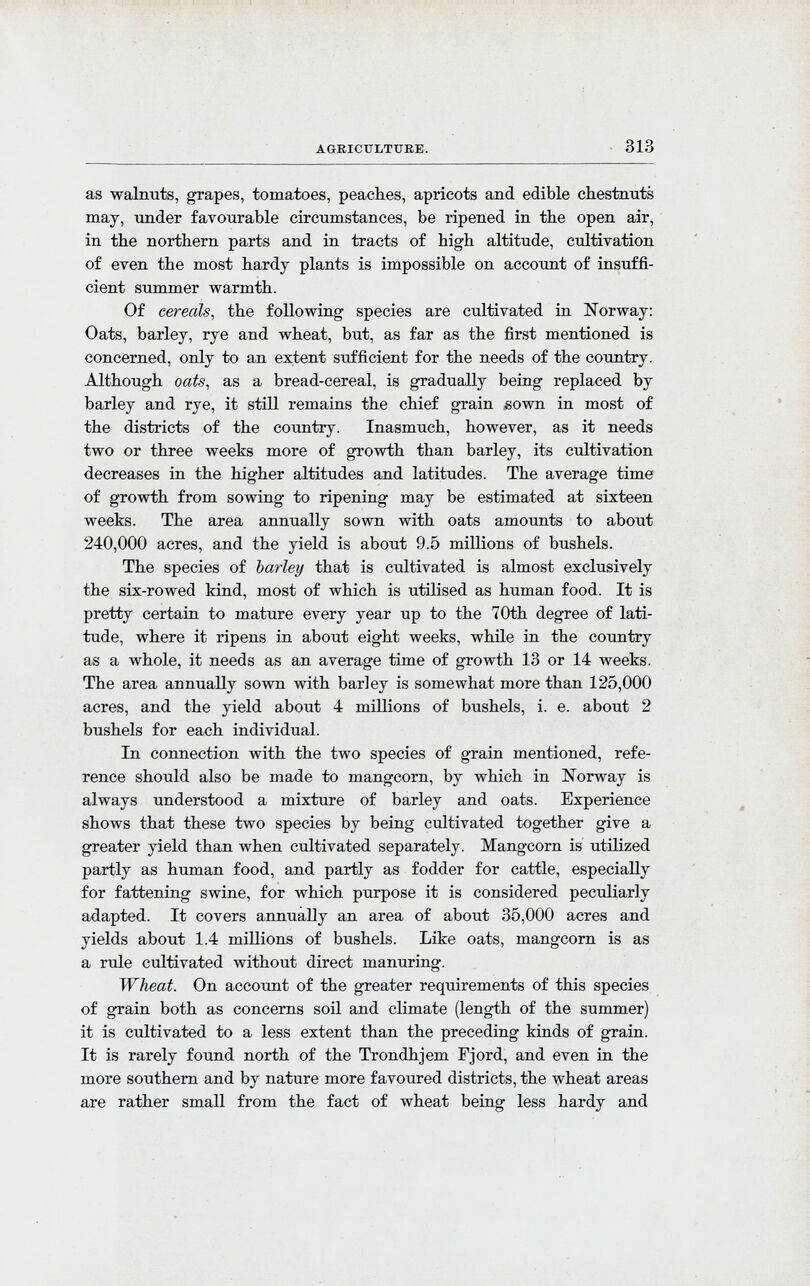
Full resolution (JPEG) - On this page / på denna sida - Agriculture, by G. Tandberg

<< prev. page << föreg. sida << >> nästa sida >> next page >>
Below is the raw OCR text
from the above scanned image.
Do you see an error? Proofread the page now!
Här nedan syns maskintolkade texten från faksimilbilden ovan.
Ser du något fel? Korrekturläs sidan nu!
This page has been proofread at least once.
(diff)
(history)
Denna sida har korrekturlästs minst en gång.
(skillnad)
(historik)
as walnuts, grapes, tomatoes, peaches, apricots and edible chestnuts
may, under favourable circumstances, be ripened in the open air,
in the northern parts and in tracts of high altitude, cultivation
of even the most hardy plants is impossible on account of
insufficient summer warmth.
Of cereals, the following species are cultivated in Norway:
Oats, barley, rye and wheat, but, as far as the first mentioned is
concerned, only to an extent sufficient for the needs of the country.
Although oats, as a bread-cereal, is gradually being replaced by
barley and rye, it still remains the chief grain sown in most of
the districts of the country. Inasmuch, however, as it needs
two or three weeks more of growth than barley, its cultivation
decreases in the higher altitudes and latitudes. The average time
of growth from sowing to ripening may be estimated at sixteen
weeks. The area annually sown with oats amounts to about
240,000 acres, and the yield is about 9.5 millions of bushels.
The species of barley that is cultivated is almost exclusively
the six-rowed kind, most of which is utilised as human food. It is
pretty certain to mature every year up to the 70th degree of
latitude, where it ripens in about eight weeks, while in the country
as a whole, it needs as an average time of growth 13 or 14 weeks.
The area annually sown with barley is somewhat more than 125,000
acres, and the yield about 4 millions of bushels, i. e. about 2
bushels for each individual.
In connection with the two species of grain mentioned,
reference should also be made to mangcorn, by which in Norway is
always understood a mixture of barley and oats. Experience
shows that these two species by being cultivated together give a
greater yield than when cultivated separately. Mangcorn is utilized
partly as human food, and partly as fodder for cattle, especially
for fattening swine, for which purpose it is considered peculiarly
adapted. It covers annually an area of about 35,000 acres and
yields about 1.4 millions of bushels. Like oats, mangcorn is as
a rule cultivated without direct manuring.
Wheat. On account of the greater requirements of this species
of grain both as concerns soil and climate (length of the summer)
it is cultivated to a less extent than the preceding kinds of grain.
It is rarely found north of the Trondhjem Fjord, and even in the
more southern and by nature more favoured districts, the wheat areas
are rather small from the fact of wheat being less hardy and
<< prev. page << föreg. sida << >> nästa sida >> next page >>